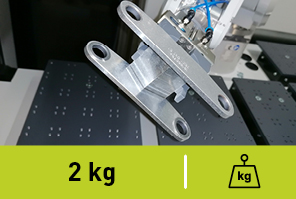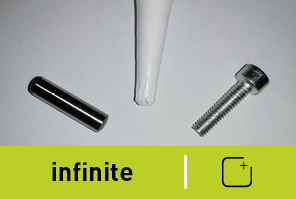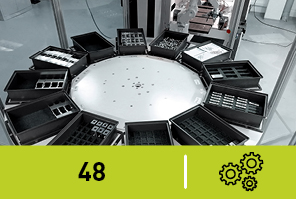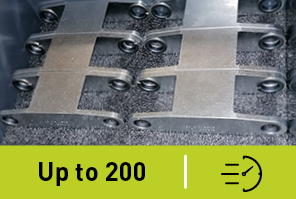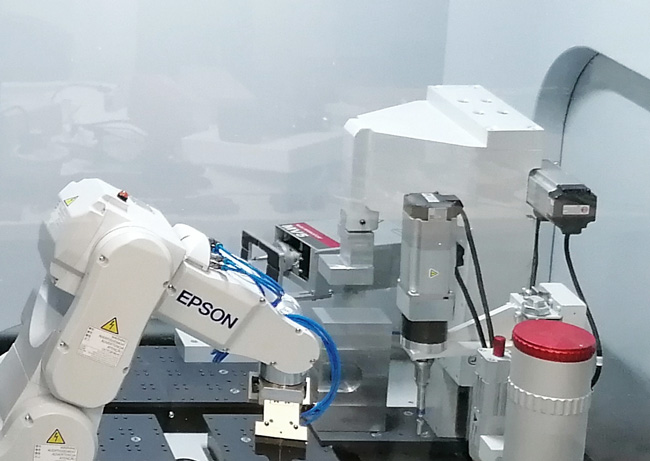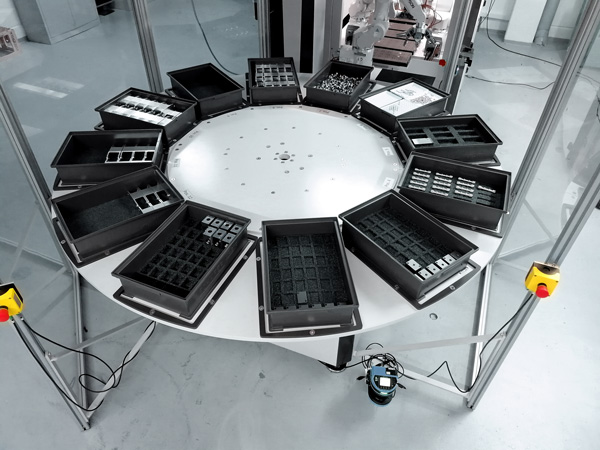AS base / AS integrated
Machines for automatic assembly
- Universal
- Expandable (modular system)
- Also for small quantities
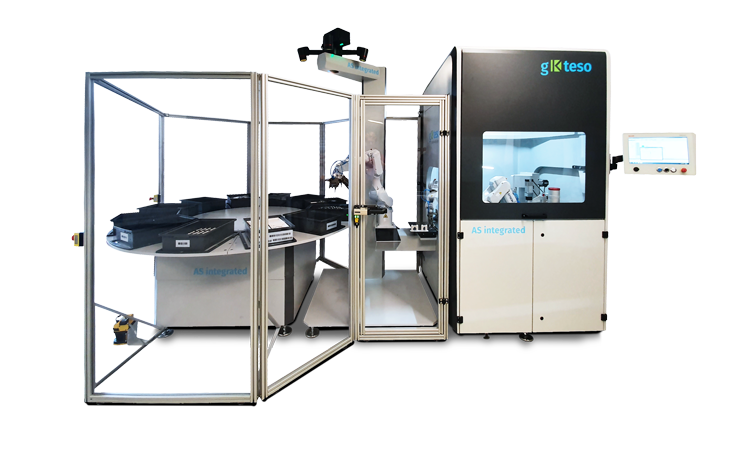
Convertible daily
Open a new direction of cost reduction with gkteso
The AS integrated flexible assembling system consists of the compact assembly cell as well as a camera-assisted separation robot outside the assembly cell plus a turntable for the material feed. The flexible assembly cell can be easily converted and is thus available for new tasks on a daily basis. The AS integrated assembling system enables different assembly production in day and night shifts and is particularly suitable for medium batch sizes and components weighing up to two kilograms. Instead of setting up an assembly line with high space requirements, many different assembly tasks can be carried out fully automatically within the flexible assembly cell. A modular system allows the individual adaptation of the system to future needs: The assembly cell can therefore be equipped with four or more robots that guide the parts to different processing points. The great flexibility of the AS integrated assembling system makes the assembly of variants particularly efficient.
AS integrated and the most common processes
- Gluing
- Screws
- Greasing
- Pressing in
- Inserting
- Testing
High throughput when assembling various components
- Quickly convertible
- Precise, fast universal
- High throughput
High throughput in the assembly of subassemblies
Do you have questions about how to automate your assembly with gKteso machines? Then call us or write to us
+49 8234 966 38 41
- 30 years of experience
- Specialists in the automation of assembly
- Sophisticated modular system
Want to know more about the possibilities of automated assembly?
We are looking forward to your inquiry!
Optimize your production
Production systems from gKteso
Production processes change
The AS integrated assembly cell from gKteso changes with
In the fast-paced industrial environment, changes within production processes are frequent and constantly present companies with new challenges. Flexible production systems such as the AS integrated (assembling system) are therefore in demand. This is because innovative production systems enable rapid adjustments and process changes. The machining programs are created once, saved and can then be called up at the touch of a button – a major advantage of versatile production systems. Several different work steps, such as gluing, screwing, greasing and press-fitting, are carried out within a single assembly cell. Comprehensive production systems thus ensure particularly short distances and reduced handling times. The high level of automation results in improved quality and reproducible results. Final checks and markings can also be integrated into the production systems thanks to the modular principle
Advantages
- Lower production costs
- More flexible response to production fluctuations
- Quick changeover
Integrated logistics
Saves costs
Adaptive logistics modules
The assembly system is already prepared for fully automated logistics systems
Automatic transport systems are becoming increasingly important not only in logistics centers, but also in industrial environments. Automatic transport systems thus ensure a steady and smooth inflow of material in production and, at the same time, the outflow of semi-finished or finished parts. Driverless transport systems orient themselves with the help of barcodes or RFID technology, for example. The AS integrated is designed so that automatic transport systems can take over the supply of the marked material boxes and bring finished machined parts into the warehouse. In combination with our separation robot, almost unmanned operation is thus possible. The camera system supports the separation robot and even individual screws can be removed and transferred to the robots inside the assembly cell. In combination with an automatic transport system, the AS integrated is ideally equipped for fully automatic assembly in shift operation.
Advantages:
- Personnel can be used for other activities
- Cost reduction
- Easy handling
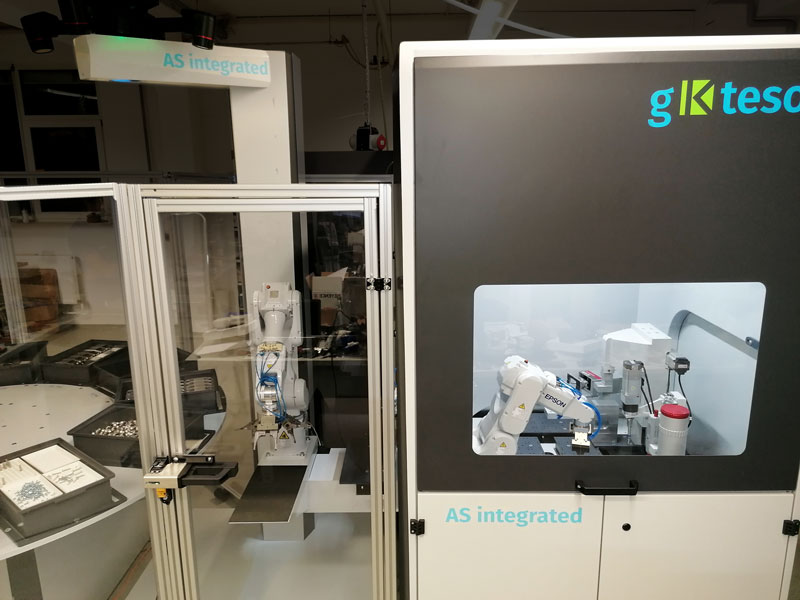
Advantages
- For different assembly activities
- Flexible and quickly convertible
- Modular construction system

Gluing
Thanks to innovative adhesives and two-component adhesives, robot gluing is becoming increasingly important in assembly. When using adhesives …
Screws
Inserting screws in a wide variety of sizes precisely and with a controlled torque is the task for the screwdriving robot within the assembly cell. Each screw …
Greasing
In the AS integrated, automated greasing also runs like clockwork. Very precisely and always with the same quantity, certain points on components can be optimized …
Pressing in
Press-fitting cylindrical pins, pressing on bearings or sliding bushings – even this assembly step is taken into account in the AS integrated assembling system. Various …
Inserting
One important task for automated assembly systems is the insertion of parts into an assembly or component. Robot applications include gripping the part and placing …
Testing
The final checking of components may include leak testing, functional testing, electrical testing, or dimensional testing. These tests can be carried …
Marking
Marking is important for traceability and identification of components and assemblies. The production date and a batch number can be …
Robot gluing
Process-safe / Fine dosing
Thanks to innovative adhesives and two-component adhesives, robot gluing is becoming increasingly important in assembly. When using adhesives, the most important thing is precision in application and economical handling of the material. In automated joining processes, robots glue with particular reliability at the same point every time and with predefined quantities. Glued joints are used in numerous industries such as electronics, the textile industry, in the sanitary sector or for packaging. Because two-component adhesives have shorter working and setting times, they can also be easily processed by robot gluing in the AS integrated. Finely applied spray adhesives are also possible by using suitable nozzles in the flexible assembly cell. Robot gluing enables a particularly even and fine layer to be applied.
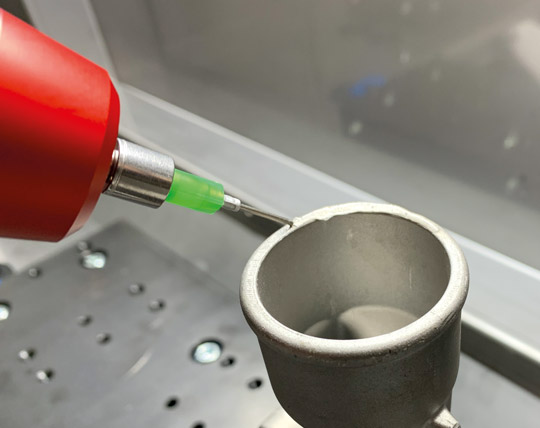
- Process secure
- Fine dosing
- 2 components glue
Automated greasing
Precise dosing and resource-saving
In the AS integrated, automated greasing also runs like clockwork. Very precisely and always with the same quantity, certain points on components can be optimized by automated greasing and prepared for further assembly. Whether for sliding bushings, gears, cylindrical pins, pistons, shafts, ball cups, bearings or springs – automated greasing by the robot in combination with a lubricant pump or a metering valve in the AS integrated succeeds with reproducible results even in hard-to-reach places. The grease can be applied over the entire surface of functional surfaces on mechanical components or specifically at defined points and in drill holes. Automated greasing is particularly resource-saving and economical due to exact metering.
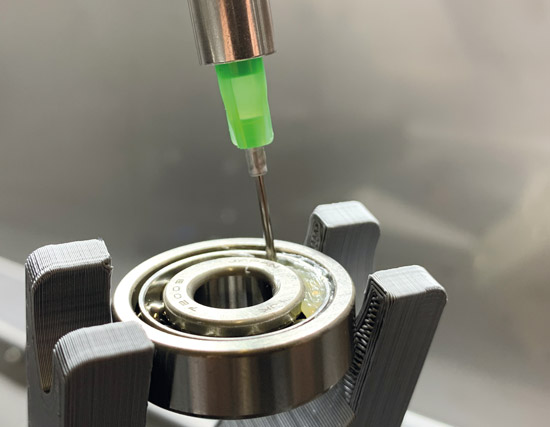
- Even poorly accessible places possible
- Finest dosage
- Spray application also possible
Press in
Also high press-in forces / Different processes
Press-fitting cylindrical pins, pressing on bearings or sliding bushings – even this assembly step is taken into account in the AS integrated assembling system. Various processes can be implemented with high press-fitting forces. Parts to be joined are stably connected by press-fitting them. For this purpose, the robot installed in the assembly cell picks up the corresponding component and guides it to the permanently mounted processing point within the assembly cell. Here, press-fitting is performed using a tool designed for this purpose and the press-fit pressure defined according to the task. After press-fitting, the robot moves the component on to the next processing step or passes it out of the assembly cell to the finished parts.
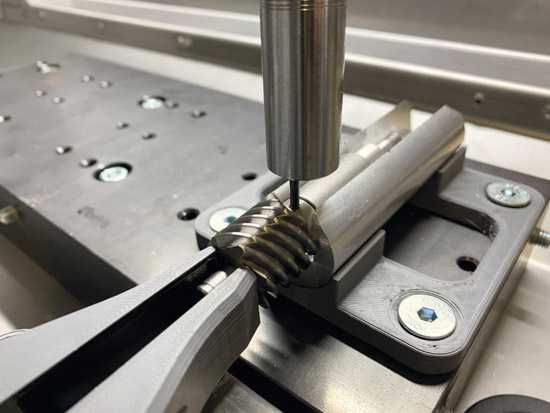
- Cylindrical pins
- Ball bearing
- Rivets
Insert
Inserting of parts
One important task for automated assembly systems is the insertion of parts into an assembly or component. Robot applications include gripping the part and placing it precisely in the right place and in the correct positioning. For example, a circuit board can be inserted into a component, or a sliding piece, spring or connector can be inserted as required. Insertion is a standardized routine activity, which is often a burden for employees due to the same manual steps being performed over and over again. Automated assembly systems reliably take over the gripping of the material and the insertion of the parts at the intended locations. Robot areas of application thus streamline the entire workflow and enable people to take on more meaningful and varied activities within the production process.
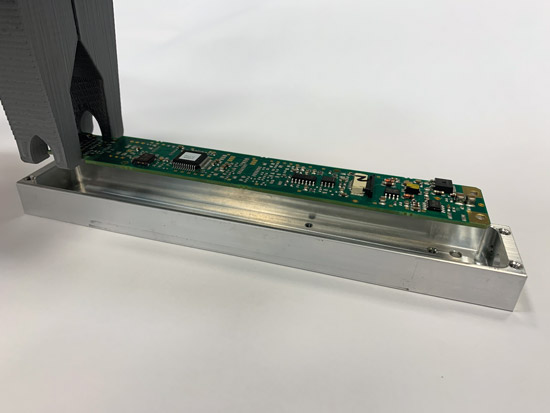
- Process-safe insertion
- Different parts
Testing
Leak tests
Functional tests
Dimensional tests
The final checking of components may include leak testing, functional testing, electrical testing, or dimensional testing. These tests can be carried out in the assembly cell after completion of the upstream production steps so that the quality of the components is particularly high. Depending on the requirements, a wide variety of test procedures are conceivable and can be implemented according to the customer’s needs. Integrated checking enables the efficient testing of each individual component, creating one hundred percent control of the assembly process. Spot checks by quality representatives can be omitted because the AS integrated assembling system reliably reports any part that does not meet the previously defined inspection criteria.
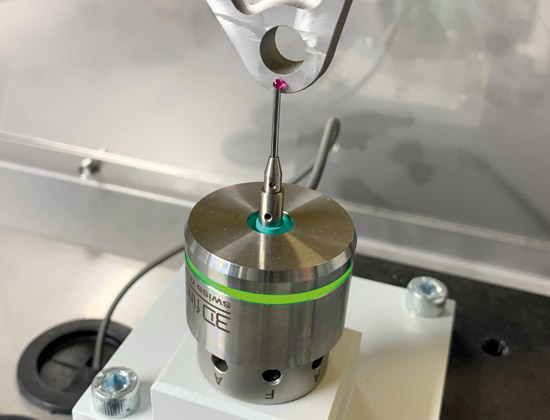
- Quality improvement
- 100% control
Screws
With controlled torque
can be combined with screw lock
Inserting screws in a wide variety of sizes precisely and with a controlled torque is the task for the screwdriving robot within the assembly cell. Each screw is perfectly tightened in a process-secure manner, thus enhancing the quality of the assembly process. But the screwdriving robot can do even more. In conjunction with a gluing station, a screw locking device can also be applied which later prevents independent loosening even under adverse conditions. The screwdriving robot relieves employees of repetitive routine tasks and at the same time ensures superlative quality and reproducible results. The screw is still the most frequently used fastening element in production for fixing components and can be used with the screwdriving robot in high cycle rates. Assembling parts, mounting handles or fastening housings – with the screwdriving robot in the AS integrated, a wide variety of applications can be implemented easily and flexibly in numerous industries.
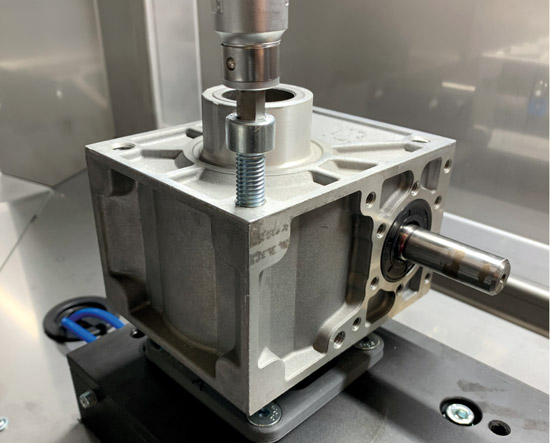
- Many screw types possible
- Constant tightening torque
Mark
Production date and batch number
Marking is important for traceability and identification of components and assemblies. The production date and a batch number can be noted on each individual part, for example. After careful inspection of the part, marking is the final step in the automated assembly cell. Which method is used for marking can be selected on a modular basis and adapted to the material of the components.
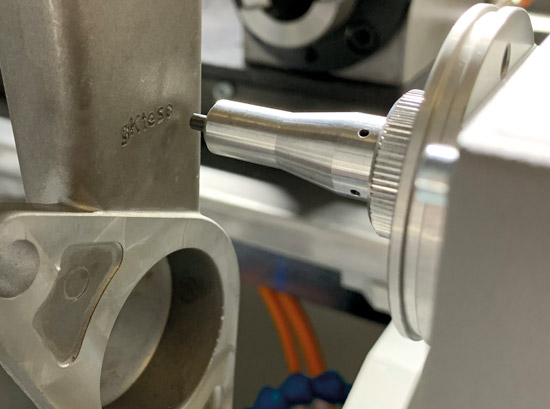
- Traceability
- Identification
Are you also interested in:
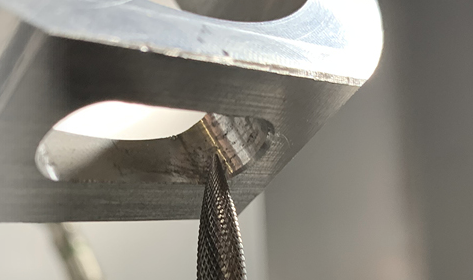
Deburring with the robot
Automotive industry, hardware industry and other industries benefit from high economic efficiency
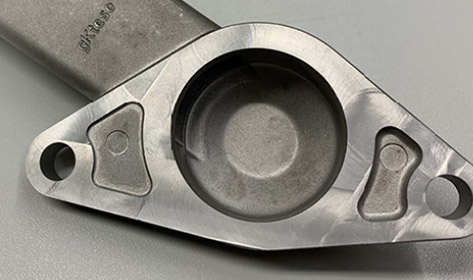
Finish machining of castings
Fully automatic, multi-axis finishing machine delivers perfect results
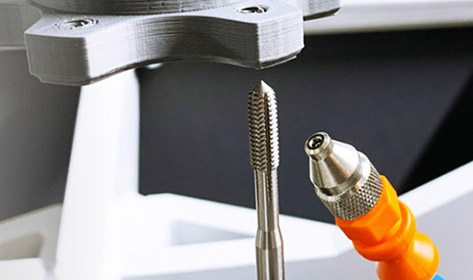
Plastic parts processing
Finishing plastic components with gKteso
